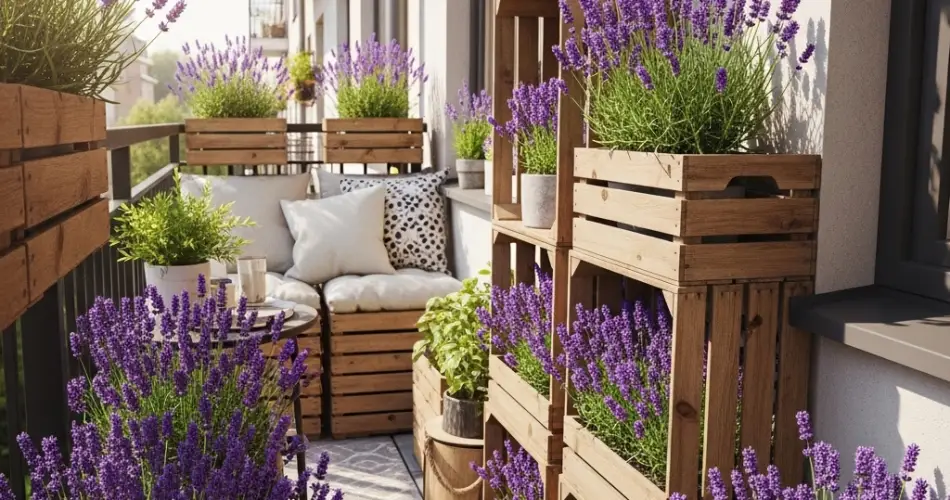Lavender is more than just a fragrant herb—it’s a visual delight and a pollinator magnet. With its calming scent, attractive purple blooms, and low-maintenance nature, lavender is a perfect addition to any balcony garden. Growing lavender in wooden crates not only enhances the plant’s rustic appeal but also offers a practical and stylish way to cultivate this versatile plant in small spaces. Whether you’re aiming for a Mediterranean feel or simply want to add charm and aroma to your balcony, lavender in crates is an elegant and rewarding solution.
Why Lavender in Crates?
Crate gardening is an ideal method for balcony growers because it makes use of compact containers while creating a decorative, organized look. Wooden crates complement lavender’s natural aesthetic, echoing the plant’s traditional use in countryside gardens and Provencal landscapes. Crates are also easy to move and rearrange, which is helpful when adjusting for sunlight or changing seasons.
Lavender thrives in well-drained soil and doesn’t need deep containers, making shallow to medium-depth wooden crates a great fit. With proper preparation, crates allow excess moisture to drain while maintaining enough space for healthy root development.
Best Lavender Varieties for Containers
Several types of lavender grow well in containers. When choosing a variety for crate gardening, consider these popular options:
-
English Lavender (Lavandula angustifolia): Ideal for culinary use and known for its strong fragrance.
-
French Lavender (Lavandula dentata): Distinctive toothed leaves and elegant flowers; tolerates humidity better.
-
Spanish Lavender (Lavandula stoechas): Compact and decorative, with butterfly-shaped flower bracts.
-
Lavandin (Lavandula x intermedia): A hybrid with long stems and intense aroma, often used for essential oils.
Choose a compact or dwarf variety if your crate is small or your balcony gets limited sunlight.
Materials You’ll Need
-
A wooden crate (untreated wood is best)
-
Landscaping fabric or coconut coir to line the crate
-
Gravel or small stones for drainage
-
Well-draining potting mix (preferably sandy or gritty)
-
Compost (in small amounts)
-
Lavender seedlings or nursery plants
-
Watering can
Preparing the Crate
Start by lining the inside of the wooden crate with landscaping fabric or coconut coir to prevent soil loss while allowing water to drain. Make sure the crate has drainage holes or gaps between the slats at the bottom. If needed, drill a few holes for proper water flow.
Add a thin layer of gravel or pebbles to the bottom of the crate to enhance drainage. Then fill the crate with a well-draining potting mix blended with sand or perlite. Lavender prefers soil that mimics its native Mediterranean habitat—light, slightly alkaline, and not overly rich.
Mix in a small amount of compost to provide some nutrients, but avoid heavy fertilization. Too much richness in the soil can lead to excessive foliage and weak flowering.
Planting and Placement
Plant lavender seedlings about 20–30 cm apart, depending on the variety. Gently loosen the root ball before placing the plant in the soil. Press down lightly and water thoroughly after planting.
Lavender needs full sun—at least 6 to 8 hours daily. Position your crate where it can receive the most sunlight, such as a south-facing balcony ledge, open railing, or sunny wall shelf. If needed, rotate the crate every few days to ensure even sun exposure.
Watering and Feeding
Lavender is drought-tolerant and prefers dry conditions over soggy soil. Water only when the top few centimeters of soil are dry. In very hot weather, you may need to water once or twice a week, but always allow the soil to dry out between waterings.
Avoid frequent fertilization. A light feeding of compost in early spring is sufficient. Overfeeding can reduce essential oil production and weaken the plant’s signature fragrance.
Maintenance and Pruning
Lavender benefits from regular pruning to maintain shape and encourage blooming. After the main flowering period, trim back the flower stalks and about one-third of the plant’s height, being careful not to cut into the woody base. Light pruning in early spring can also help rejuvenate older plants.
Deadheading—removing spent flowers—can encourage a second round of blooms and keeps the plant looking neat.
Winter Care
If your region experiences cold winters, protect the lavender during the colder months. Move the crate to a sheltered spot, such as near a wall or under a roof overhang. Alternatively, cover the plant with a breathable frost cloth. Lavender can handle cool temperatures but doesn’t tolerate waterlogged or frozen roots.
In mild climates, the plant can stay outdoors all year with minimal protection.
Conclusion
Growing lavender in crates offers a beautiful way to bring fragrance, color, and life to your balcony. This decorative yet practical gardening method suits small urban spaces while delivering all the benefits of this beloved herb. With its low-maintenance care routine and striking appearance, lavender in crates is the perfect choice for those who want to combine gardening function with aesthetic charm. Whether for relaxation, culinary use, or pollinator support, your lavender crate garden will be a joy throughout the growing season.



